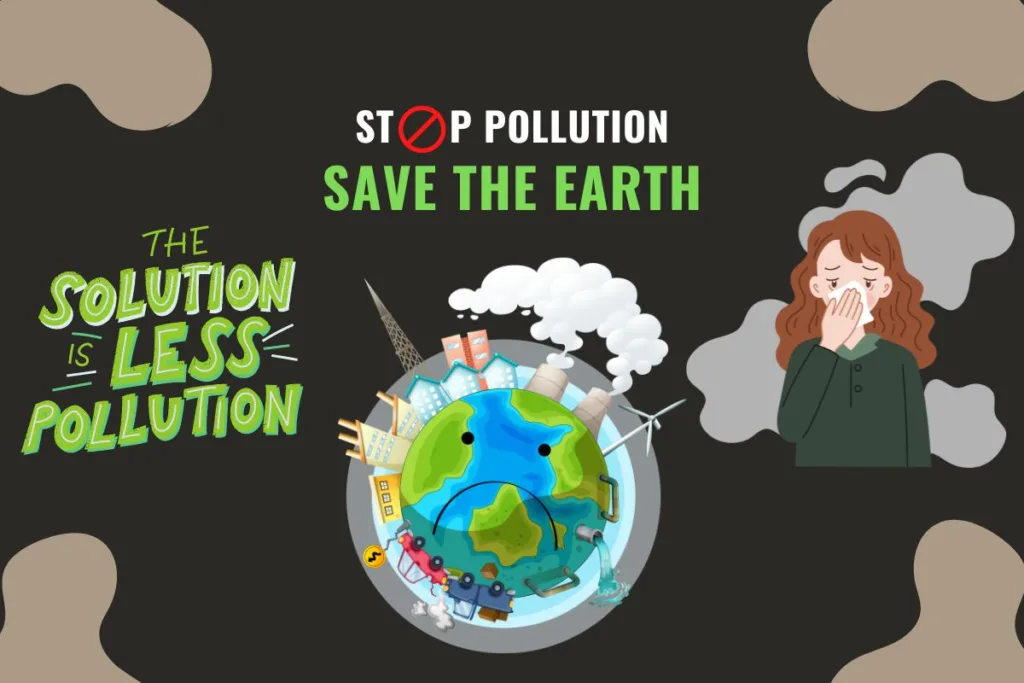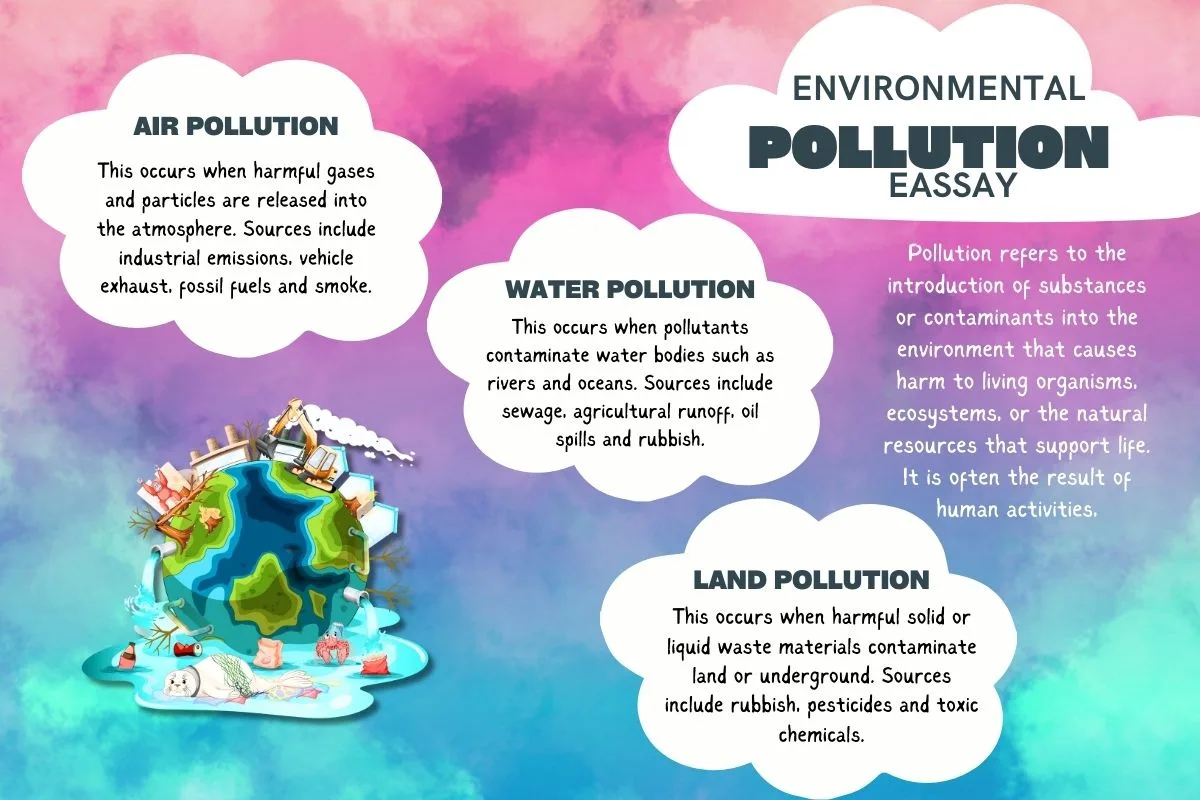Environmental pollution, a grave concern in the contemporary world, encompasses a range of issues that threaten the delicate balance of our ecosystems. From the air we breathe to the water we drink and the soil that nourishes our crops, the pervasive impact of pollution reaches every corner of the globe. As human activities intensify and industrialization advances, the repercussions on the environment become increasingly apparent. This essay aims to provide an in-depth analysis of environmental pollution, exploring its various types, regional perspectives, impacts on human health and ecosystems, regulatory measures, and technological innovations for pollution control.
Types of Environmental Pollution
Air Pollution:
Air pollution, primarily stemming from industrial emissions and vehicular exhaust, poses a severe threat to both human health and the environment. The combustion of fossil fuels releases a myriad of pollutants, including particulate matter, nitrogen oxides, sulfur dioxide, and volatile organic compounds. These pollutants not only degrade air quality but also contribute to the formation of smog and acid rain.
The impact of air pollution on human health is profound, with respiratory diseases such as asthma and chronic obstructive pulmonary disease (COPD) on the rise. Vulnerable populations, such as children and the elderly, are particularly at risk. Furthermore, air pollution detrimentally affects ecosystems by damaging vegetation, disrupting wildlife habitats, and contributing to global climate change.
International efforts to combat air pollution have seen the implementation of stringent emission standards, the promotion of renewable energy sources, and the development of cleaner technologies. However, the challenges persist, especially in densely populated urban areas where the concentration of pollutants is often highest.

Water Pollution:
Water pollution, resulting from various sources such as industrial discharges, agricultural runoff, and improper waste disposal, poses a significant threat to aquatic ecosystems and human communities. Industrial effluents often contain heavy metals, toxins, and chemicals that contaminate water bodies, rendering them unsafe for consumption and detrimental to aquatic life.
Agricultural runoff, laden with pesticides and fertilizers, exacerbates the issue by causing nutrient imbalances in water ecosystems. This not only leads to the proliferation of harmful algal blooms but also affects the quality of drinking water. Additionally, improper waste disposal, including plastic pollution, further compounds the challenges faced by marine environments.
Efforts to address water pollution have included the implementation of wastewater treatment plants, the enforcement of water quality standards, and public awareness campaigns. Success stories, such as the cleanup of severely polluted rivers, demonstrate the positive impact of concerted actions at local and national levels.
Soil Pollution:
Soil pollution, often a consequence of unsustainable agricultural practices and industrial activities, has far-reaching implications for food security and ecosystem health. The excessive use of chemical fertilizers and pesticides degrades soil quality, leading to nutrient imbalances and the loss of crucial microorganisms that support plant growth.
Industrial pollutants, such as heavy metals and toxic chemicals, can persist in the soil for extended periods, posing risks to both plants and animals. Contaminated soil not only compromises agricultural productivity but also threatens the health of those consuming crops grown in polluted areas.
Efforts to combat soil pollution involve sustainable agricultural practices, soil conservation measures, and the remediation of contaminated sites. The adoption of organic farming methods, agroforestry, and the use of phytoremediation techniques has shown promise in restoring soil health and preventing further degradation.
Continued efforts and global collaboration are essential to address the multifaceted challenges posed by air, water, and soil pollution. As we delve deeper into the various types of environmental pollution, it becomes evident that a comprehensive approach is necessary to safeguard the planet for future generations.
In short Types of Environmental Pollution Table
| Types of Environmental Pollution | Air Pollution | Water Pollution | Soil Pollution |
|---|---|---|---|
| Sources | Mainly industrial emissions and vehicle exhaust | Industrial discharges, agricultural runoff, improper waste disposal | Unsustainable agricultural practices, industrial activities |
| Major Pollutants | Particulate matter, nitrogen oxides, sulfur dioxide, volatile organic compounds | Heavy metals, toxins, chemicals, pesticides, fertilizers | Chemical fertilizers, pesticides, heavy metals, toxic chemicals |
| Consequences | Degrades air quality, contributes to smog and acid rain | Threatens aquatic ecosystems and human communities | Implications for food security and ecosystems |
| Health Impact | Rise in respiratory diseases, especially asthma and COPD | Unsafe water for consumption, harmful algal blooms, compromised drinking water quality | Compromises agricultural productivity, threatens human health |
| Environmental Impact | Harms ecosystems, damages vegetation, disrupts wildlife habitats, contributes to climate change | Harms aquatic life, disrupts ecosystems, contributes to eutrophication | Persists in the soil, threatening plant and animal life, compromises biodiversity |
| Mitigation Efforts | Stringent emission standards, promotion of renewable energy, development of cleaner technologies | Wastewater treatment, water quality standards enforcement, public awareness campaigns | Sustainable agricultural practices, soil conservation, site remediation |
| Success Stories | Implementation of cleaner technologies, reduced industrial emissions | Cleanup of severely polluted rivers, improved water quality in certain regions | Adoption of organic farming methods, successful soil remediation projects |
Impact on Human Health
Environmental pollution poses severe and diverse threats to human health, warranting urgent attention. The consequences extend beyond immediate concerns, encompassing a spectrum of ailments and chronic conditions. This section delves into the multifaceted impact, emphasizing the need for comprehensive strategies to safeguard public health.
- Respiratory Health:
The surge in environmental pollutants correlates with a rise in respiratory diseases, notably asthma and chronic obstructive pulmonary disease (COPD). Airborne pollutants, including particulate matter and hazardous gases, infiltrate the respiratory system, triggering inflammation and laying the groundwork for long-term health complications. - Waterborne Diseases:
A distinct facet of the health impact stems from contaminated water sources, fostering the proliferation of waterborne diseases. Pathogens thriving in such environments give rise to ailments like cholera, dysentery, and gastrointestinal infections. The absence of proper sanitation and access to safe drinking water contributes significantly to the global burden of preventable diseases. - Chronic Conditions:
A mounting body of evidence underscores the association between prolonged exposure to environmental pollutants and chronic conditions. Cardiovascular diseases and specific cancer types have been linked to environmental factors. Vulnerable demographics, including children, the elderly, and those with pre-existing health conditions, face heightened risks. - Holistic Health Approach:
Addressing the health impacts necessitates a holistic approach, combining targeted interventions and broad-spectrum strategies. Public health initiatives, emphasizing access to clean water and improved sanitation facilities, play a pivotal role in mitigating the immediate health threats posed by pollution. - Awareness Campaigns and Lifestyle Changes:
Beyond infrastructure enhancements, raising awareness is paramount. Informative campaigns highlighting the perils of pollution empower communities to make informed choices. Encouraging lifestyle changes, such as promoting active transportation and reducing dependence on fossil fuels, contributes not only to environmental conservation but also to overall health improvement.
Impact on Wildlife and Ecosystems
Environmental pollution doesn’t just affect people; it’s a big problem for animals and nature too. Let’s dive into why it’s a concern.
- Disturbing Habitats:
Think about your home suddenly becoming dirty and uncomfortable. Pollution does something similar to the homes of animals and plants. It disrupts their spaces, making it challenging for them to live comfortably. - Loss of Unique Species:
Nature is like a large family with various members – big, small, furry, and leafy. Pollution acts like a disruptor, making it difficult for some family members, especially the smaller or more sensitive ones, to survive. This means we might lose some of the unique animals and plants that make nature diverse and fascinating. - Contaminated Water, Unhappy Aquatic Life:
Imagine if the water you rely on becomes filled with harmful substances. That’s what happens to fish and other aquatic creatures when pollution makes water dirty. They get sick, and some struggle to breathe. Imagine living in a place where you can’t breathe properly! - Land Pollution Woes:
Land pollution, such as excessive plastic and chemical use, is akin to making a mess in someone’s backyard. Animals and plants in that area face difficulties. The plants can’t grow properly, and the animals might ingest or get entangled in the plastic. - Farewell to Biodiversity:
When pollution reaches a point of no return, some animals and plants can’t survive anymore. It’s like saying goodbye to friends in nature. This leads to a sadder and quieter environment, which isn’t how nature is meant to be.
What Can We Do:
To aid wildlife, plants, and nature, we need to stop creating a mess. Cleaning up after ourselves, reducing plastic use, and being mindful of the Earth are steps in the right direction. By taking care of nature, we ensure it remains a happy and lively home for all its members – big, small, furry, and leafy!
Regulatory Measures and Policies for Environmental Pollution
Addressing environmental pollution is a global priority, leading to the development and implementation of various rules and policies. These measures aim to control harmful emissions, manage waste responsibly, and encourage sustainable practices across different industries.
- International Agreements:
Global cooperation is crucial in tackling environmental issues. The Paris Agreement, established in 2015, focuses on reducing global temperature increases to combat climate change. Another example is the Montreal Protocol, which targets the protection of the ozone layer by phasing out substances that deplete it. - National Policies:
Countries worldwide have put in place policies to deal with pollution within their borders. These policies often set standards for industries, regulate waste disposal, and provide incentives for adopting cleaner technologies. The effectiveness of these policies varies and depends on factors like political commitment, enforcement methods, and public involvement. - Market-Based Instruments:
Economists and policymakers are exploring market-based tools to tackle environmental pollution. Examples include carbon pricing mechanisms like carbon taxes and cap-and-trade systems. By putting a price on carbon emissions, these tools aim to make industries consider the environmental costs of pollution and encourage cleaner practices. - Environmental Impact Assessments (EIAs):
Before approving industries or development projects, many countries require them to undergo environmental impact assessments (EIAs). These assessments evaluate the potential environmental effects of proposed actions and suggest measures to minimize or prevent adverse impacts. This process helps protect the environment. - Challenges and Opportunities:
While regulatory measures exist, challenges persist in enforcing and monitoring them, as well as fostering international cooperation. The rules need constant adjustments to keep up with changes in pollution sources and patterns. Strengthening enforcement, improving transparency, and encouraging collaboration among governments, industries, and civil society are crucial steps forward.
In summary, global efforts to combat environmental pollution involve a mix of international agreements, national policies, market-based approaches, and assessments to protect the environment. Overcoming challenges and seizing opportunities will be vital in making these measures effective in the ongoing fight against pollution.
Technological Innovations for Pollution Control
Dealing with environmental pollution is a complex task, and technology plays a key role in finding sustainable solutions. Progress in different areas helps control pollution, covering everything from cleaner energy technologies to inventive waste management methods.
- Clean Energy Technologies:
One crucial step in reducing air pollution and fighting climate change is moving away from fossil fuels. Clean energy sources like solar, wind, hydroelectric, and geothermal technologies offer eco-friendly alternatives, decreasing our dependence on coal and oil. Governments, along with research and development investments, have sped up the use of these technologies worldwide. - Renewable Energy Storage:
Renewable energy sources, like solar and wind, can be unpredictable. So, having efficient ways to store that energy is important. Advances in battery technologies, such as lithium-ion batteries and newer ones like solid-state batteries, allow us to store extra energy generated during peak times for later use. - Smart Grid Technologies:
Smart grids are like tech-savvy energy networks that efficiently manage electricity supply and demand. They help integrate renewable energy sources, reduce energy wastage, and enhance overall grid reliability. This intelligent approach to energy distribution contributes to pollution control efforts. - Waste-to-Energy Conversion:
Instead of letting waste pile up in landfills, technological innovations allow us to convert it into energy. Processes like incineration, anaerobic digestion, and gasification turn waste into heat or electricity, reducing the environmental impact of waste disposal. - Air Quality Monitoring Systems:
Technology helps us keep a close eye on the air we breathe. Advanced monitoring systems provide real-time data on air quality, helping identify pollution sources and assess the effectiveness of pollution control measures. This information is crucial for creating targeted strategies to improve air quality.
In conclusion, technological innovations are crucial in our fight against environmental pollution. From cleaner energy sources to smart grids and waste-to-energy conversion, these advancements offer practical and sustainable solutions. By embracing and continually improving these technologies, we can make meaningful progress in creating a healthier and cleaner environment for everyone.
Environmental Pollution impact on Developed vs. Developing Countries:
| Aspect | Developed Countries | Developing Countries |
|---|---|---|
| Pollution Disparities | Disparities in pollution levels highlight the complex interplay between economic development and environmental degradation | Face disparities in pollution levels due to rapid industrialization and challenges in regulatory framework establishment |
| Environmental Regulations | Often have robust environmental regulations | Face challenges in establishing effective regulatory frameworks, leading to potential environmental management issues |
| Challenges Faced | Grapple with industrial emissions, waste management challenges | Face hurdles in managing rapid industrialization and may struggle with waste management and pollution control |
| Globalization Impact | Environmental impacts may still be significant, contributing to global pollution patterns | Interconnected economies lead to the globalization of pollution, with regional impacts reverberating globally |
| Transboundary Pollution | Limited transboundary pollution concerns within their borders | Experience transboundary pollution, where pollutants originating in one country affect neighboring regions |
| Need for International Cooperation | Generally proactive in international cooperation on environmental issues | Emphasize the need for international collaboration to address environmental challenges |
| Paris Agreement Involvement | Active participation in global agreements like the Paris Agreement | Engage in global initiatives such as the Paris Agreement, seeking collaborative solutions for sustainable development |
| Technology Transfer | Advanced in sustainable technologies, potentially involved in technology transfer initiatives | May receive support in the form of sustainable technology transfer, financial assistance, and capacity building |
| Financial Assistance | Potentially provide financial assistance for sustainable development projects | May receive financial assistance to support sustainable practices and initiatives |
| Capacity Building Initiatives | Well-established capacity for environmental management and sustainable practices | May require capacity building to enhance environmental management capabilities |
| Goal of Sustainable Economic Growth | Economic growth occurs within established environmental sustainability frameworks | Aim to ensure economic growth aligns with environmental sustainability principles |
Environmental Pollution impact on Urban Environments vs. Rural Environments
| Aspect | Urban Environments | Rural Environments |
|---|---|---|
| Characteristics | Concentrated industrial activities, high population densities | Reliance on agriculture, lower population densities |
| Air Quality Challenges | Industrial emissions and vehicular exhaust contribute to poor air quality | Agricultural practices, including pesticide and fertilizer use, may impact air quality |
| Waste Management Issues | High waste generation, challenges in efficient waste disposal | Agricultural waste, with potential challenges in disposal and recycling |
| Access to Clean Water | May face issues of contamination in water sources | Agricultural runoff may impact water quality, access to clean water may be challenging |
| Urban Heat Island Phenomenon | Intensified due to concentrated human activities, impervious surfaces | Absence or reduced impact due to lower concentration of structures and vegetation |
| Health and Well-being Impact | Increased health risks due to air and water pollution, noise, and stress | Health risks may be associated with agricultural practices, but potentially lower levels of pollution exposure |
| Mitigation Strategies | Implementation of green spaces, improved public transportation, transition to renewable energy sources | Emphasis on sustainable agricultural practices, afforestation, and community-based conservation efforts |
| Environmental Impact on Ecosystems | Disruption of natural ecosystems, loss of biodiversity | Potential impact on local ecosystems, but often less pronounced compared to urban areas |
| Community Livelihoods | Diverse economic opportunities, but potential disparities and challenges in access to resources | Reliance on agriculture and traditional livelihoods, potential vulnerability to environmental changes |
| Role of Urban Planning | Crucial for addressing pollution challenges, enhancing sustainability | Emphasis on preserving rural landscapes, maintaining traditional agricultural practices |
| Technological Integration | Adoption of advanced technologies for waste management, transportation, and energy | Emphasis on appropriate and sustainable technologies in agriculture, limited use of advanced urban technologies |
| Government Policies and Support | Varied policies addressing urban pollution, often more resources allocated | May face challenges in policy implementation, resource allocation, and infrastructure development |
| Public Awareness and Education Programs | Higher levels of awareness, education, and advocacy programs | Varied awareness levels, ongoing efforts to increase understanding of environmental issues |
Conclusion
In conclusion, tackling environmental pollution is an urgent collective task. From urban centers to rural areas, the impacts on health and ecosystems are evident. Comprehensive strategies, regulatory measures, and technological innovations offer hope, but individual and collective actions are crucial. The journey toward a cleaner future demands shared commitment, emphasizing our responsibility as stewards of the Earth for a sustainable tomorrow.


What’s up, every time i used to check web site posts here in the early
hours in the dawn, since i like to learn more and more.